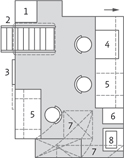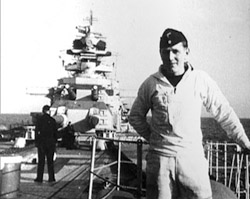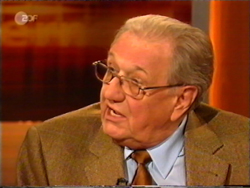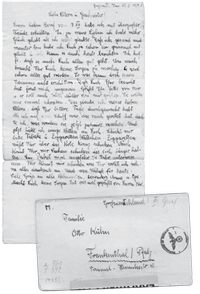|

Ship's office II
(Upper deck, Department VIII)
1 |
Secret locker |
2 |
Stairway to the superstructure deck |
3 |
Sliding door |
4 |
Typewriter station |
5 |
Desk |
6 |
Locker |
7 |
Air Condition |
8 |
Bathroom sink |
|
Immediately after basic training, Karl Kuhn was given his first command on board the battleship Bismarck, a choice he was very happy and proud of. In Hamburg he saw his new ship for the first time and was very impressed by its enormous dimensions. He immediately felt a sense of security. Nothing could happen to him on such a large ship, he thought, and his first impression was confirmed by his new comrades, who even declared the ship to be unsinkable. Of course he was also proud to be the first to receive such an important command. On board he was assigned to the 7th Division and deployed to the ship's office II, in the aft part of the upper deck. This was a small room with three workstations, including a typewriter. Karl Kuhn was responsible for the exchange of information between the ship's stations and the naval headquarters. The adjutant's chamber was in the immediate vicinity. The adjutant dictated orders to him, which Karl Kuhn had to record and pass on. His battle station was located far down in the ship in radio room B.
When the Bismarck left Hamburg to complete test and training trips in the Baltic Sea, Karl Kuhn was standing on the upper deck. On the shore he could see how many girls were waving to the ship with handkerchiefs. It was a very impressive sight, he later recalled. He was astonished and surprised at the great interest, as the departure date was actually a secret. Word had certainly got around, and the actual departure of such a huge ship could not remain a secret. Many of his comrades, who had already come on board for the construction instruction, had girlfriends in the city. Since there was generally little navy representation in Hamburg, they had better chances with the girls with their smart naval uniforms, Karl Kuhn recalled. He said goodbye to the Hanseatic city with some sadness, also in view of this missed opportunity, but was also looking forward to the new challenge and that things would finally get started.

The training that followed in the Baltic Sea, under the critical eye of Captain Ernst Lindemann, was more rigorous than Karl Kuhn had expected. The battle exercises that had been carried out were constantly repeated and the commander of the Bismarck always had something to criticize about their execution. For Karl Kuhn, with his station in the office, this also meant a lot of desk work, as everything was recorded precisely. The actual artillery firing seemed downright calm to him compared to the battle exercises that were constantly practiced. With a feeling of impatience and pride, he longed for the upcoming operation, so that he could finally show what they had trained so hard for all this time and what great achievements they were capable of.
At the beginning of May 1941, commander von Puttkamer (Hitler's naval adjutant) announced Hitler's planned visit to the Bismarck and dictated to Karl Kuhn exactly when he would arrive. A short time later, the eighteen-year-old, immensely proud, faced his superior for the first time, to whom he had sworn an oath. Shortly afterwards, the Bismarck set sail together with the Prinz Eugen under the command of fleet commander Admiral Lütjens. For sailor Karl Kuhn and most of his comrades, the first long-awaited combat mission began. From Gotenhafen they went through the Kattegat and the Skagerrak into the North Sea. The formation first sailed into the Norwegian fjords near Bergen, where the Prinz Eugen refueled. Karl Kuhn felt like he was on an excursion. It was a day of glorious sunshine, which he and his comrades enjoyed lying on the upper deck and looking at the fjord landscape. He had no idea that their departure had already been noticed by the enemy. He was all the more surprised when, shortly after breaking through into the Atlantic, his ship was first sighted by British ships and then engaged in battle. He followed the events as best he could from his battle station in radio room B. Given the size of the ship, it took a while for the news of the sinking of the HMS Hood to reach him. It sparked great jubilation among the crew. He didn't really realise at the time that people had died on the other side. "I never met an Englishman, but I hated them." Karl Kuhn later recalled: "It took a long time for this hatred to die out. We were so fanatical back then and at some point you ask yourself: How could it have happened? Today the former enemies have become friends. Why couldn't it have been like that back then too?"
During the night after the battle, the Bismarck was able to break away from the enemy, but was then tracked down again and pursued by even stronger forces. However, their chances of breaking through to the occupied French coast were good and Karl Kuhn was confident that they would succeed. It was only when the fleet commander gave a speech to the crew, warning them of another difficult battle in which it would be a matter of winning or dying, that he felt brought back down to earth, but his optimism remained undiminished. When the torpedo hit the rudder system on the evening of May 26, 1941, the fleet commander's warning became an unavoidable certainty for him. During the night, the enemy assembled its forces for battle the next day. In the radio room, Karl Kuhn repeatedly heard reports of the approaching heavy British units that were slowly surrounding his ship.

The next day, the unequal battle began. Karl Kuhn could only sit idly at his combat station and wait for what happened. In radio room B, located on the upper platform deck, he had a safe station, which offered him protection from enemy shells thanks to the citadel armor. He thus survived the battle raging above him unscathed. Almost everything inside the ship remained intact, including the on-board loudspeaker system, over which he heard the hit song "Come back." When the command "Ship is being blown up, abandon ship" finally reached Karl Kuhn, it was too late to calmly look for a safe escape route. He ran blindly after his comrades. On the lower decks, a frightened crowd of people pushed through the corridors in a desperate search for an opening. Karl Kuhn was lucky and found a way up. As he ran past his office, he suddenly saw a light and followed it outside. A horrific scene awaited him on deck. The damage had put the guns out of action, deformed the ship and scattered debris. Many dead bodies were lying around. On the upper deck, he made his way aft to the Dora turret, where he joined a small group of survivors. Lieutenant Müllenheim-Rechberg soon joined the group. They waited together for a good moment to jump overboard. When the moment finally arrived, Müllenheim-Rechberg ordered the men to inflate their life jackets and leave the ship. Before doing so, they greeted their fallen comrades with their hands on their caps. Then they jumped into the water one by one on the starboard side. As he drifted in the cold, heavy sea, completely helpless to save himself from his situation, Karl Kuhn was overcome with fear. He remembered: "Now I've really noticed that you're in trouble, now it's your turn." But he was lucky. The British cruiser HMS Dorsetshire rushed to the survivors' aid and rescued Karl Kuhn from the water. At 18, he was the second youngest of those rescued. Only slowly did he realize how lucky he had been to survive the sinking. The dramatic experiences stayed with him for the rest of his life.

The rescue marked the beginning of his long years as a prisoner of war. Karl Kuhn first came to England and later to Canada, where he spent a long time in the Canadian bush as a lumberjack. He had a lot of time to think and slowly became aware of whom he had actually served. After returning home, he lived in the small town of Weisenheim am Berg in the Palatinate Forest. His experiences with the Bismarck never left him. Even in old age, he continued to study the subject. When, on the sixtieth anniversary of the sinking, he was offered the opportunity to accompany a film crew on an expedition to the wreck of the Bismarck, he could not refuse.
He set off on the expedition in May 2002 together with the Bismarck survivor Walter Weintz. For both of them, it was an emotional journey back in time to their own past. When they arrived at the scene, the crew held a memorial service, visibly moved. After a speech in which they remembered the dead and passed on their personal experiences and lessons from the war with a call for peace, Walter Weintz and Karl Kuhn threw a wreath into the sea. Then the diving trips to the wreck of their ship began, and they were also invited to take part. However, Karl Kuhn and Walter Weintz had to decline the offer due to their advanced age and the great effort involved. During the diving trips, one of the submersibles sent a small remote-controlled camera robot through a bullet hole into the interior of the ship. The robot supposedly dived into the ship's office II, Karl Kuhn's old workplace on board, but this was a case of mistaken identity, which is not surprising given the great devastation. The robot actually went into the ship's officers' mess. Karl Kuhn himself did not notice the mistake; he believed he had been transported back to the place where he had worked over 60 years ago. Two years later, on May 16, 2004, Karl Kuhn died at the age of 81.
|
|